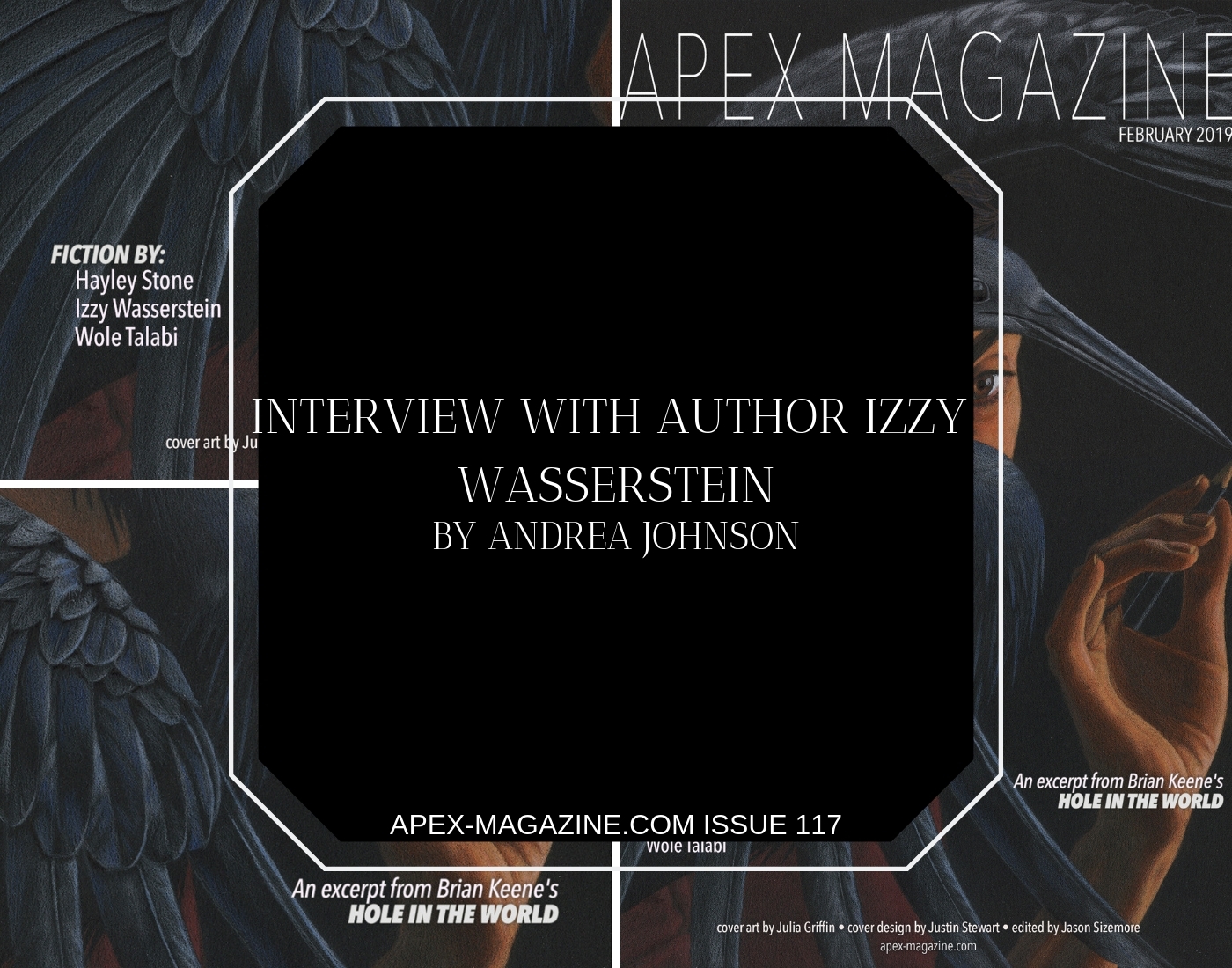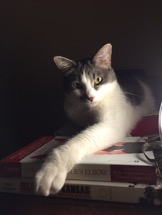
Books that whisper their stories to you, a man who loves books so much his hair has turned into hand-written pages, a vibrating city on the brink of collapse, and a conflicted woman who will do anything to keep her dying (dying … no … transforming) mother alive. And when you do finally meet Danae’s disabled mom, their home is filled with everything that lies unspoken between them.
The magic system in this story feels like a more expensive version of Ferrett Steinmetz’s Flex, whereas the world, the world-building, and the general weight of the place is more akin to N.K. Jemisin or Scott Lynch. At first blush, you’ll think you’re reading a typical low fantasy/urban fantasy story, starring a courier/sometimes thief with a heart of gold, a client with something to hide, fun chase scenes, and monsters who don’t know anything except how to kill. While you’re reading those pages, you’ll fall into the world, you’ll have a million questions (because Wasserstein is a master of making you want to know more, want to know everything!), and you’ll quickly realize this story is so much larger than a few days of Danae’s life. In fact, five years from now, Danae will probably have forgotten that these events even happened. She’ll have moved on to bigger things.
What immediately caught my attention with this story is the gorgeous world-building, and how layered it is. While this is a self-contained story, it reads like it is the introduction or a few middle chapters in a larger novel. There are characters we only get a few minutes with, there is a whole history of how and why Danae’s mom ended up with her feet planted in a bucket, not to mention the elephant on every page of the background of Danae’s magic (actually, I’m arachnophobic. Maybe I don’t want to know that part).
All that to say, if you’re looking for a master-level example of how to do world-building, characterization, tension building, and storytelling right, “The Crafter at the Web’s Heart” is where you should start. In fact, I’m going to go read it again. Be right back.
Thanks for the quick break, I’m back. Damn, Pliny is an ass. He got what he deserved. And that scene between Danae and Socha! Really, I would have been happy to read thirty pages of just Danae and Socha. That would have to be some kind of prequel story because Socha isn’t stuck in the past the way Danae is. Also? Socha has moved on.
You know, I can’t get enough of these kinds of stories, where the world revolves around mythology, gods, and creation stories. Gods need their status quo to continue, they need their stories to keep being told. I love this kind of mythology, that gods are trapped in their own stories, that they’ve made their own trap. Without the stories that trap them into an archetype, they will be forgotten, and the only way they stay alive is by people remembering them and thinking about them.
If “The Crafter at the Web’s Heart” will be your first Wasserstein, get yourself over to Clarkesworld to read Wasserstein’s “Unplaces: An Atlas of Non-Existence.” I feel like these two stories are holding hands, in a way.
Izzy Wasserstein was born and raised in Kansas, currently teaches writing and literature, and lives with a variety of animals and the writer Nora E. Derrington. She writes about queer characters, queer love, found families, resisting fascism, the power of memory, and occasionally Norse deities. Her work has appeared in Clarkesworld, Glittership, PseudoPod, Lady Churchill’s Rosebud Wristlet, and is forthcoming in the anthologies Resist Fascism: A SFF Call to Action, Robot Dinosaurs!,andA Punk Rock Future. Izzy was kind enough to talk to me about the inspiration behind “The Crafter at the Web’s Heart,” the challenge of creating a unique magic system, her new poetry collection When Creation Falls, how Borges’ Tlön has influenced her work, teaching science fiction lit at the university level, and more.
APEX MAGAZINE: This fantastic fantasy story has a little bit of everything—action, betrayal, magic, epic world-building, mythology, the maybe beginnings of a revolution. What inspired this story?
IZZY WASSERSTEIN: I suspect that my stories have two kinds of inspirations: the conscious kind, and the subconscious that I only become fully aware of later, if ever. Here, my conscious inspiration was an ongoing conversation I was having with my classmates at Clarion West (shout out to my beloved Team Eclipse) about how one might go about building a secondary world fantasy in a short story. I wanted a story that combined a memorable setting and a (hopefully) cool magic system.
The subconscious one was more personal: this is a story about embracing change and transformation. I wrote the first draft of it when I was very newly out as a trans woman. I don’t think I was fully aware of what I was doing, but in retrospect, of course I wanted to tell a story about the power of embracing transformation.

Izzy’s cat Ripley
AM: You often write about worlds that never were, the unplaces. How did you come up with Danae’s world and the city of Traverse?
IW: I don’t often know where my ideas come from, but when it comes to Traverse, I at least know where I was when it arrived: I was in bed one night, exhausted but failing to sleep, as my brain turned over story ideas, whether I wanted it to or not. An image appeared to me, a city suspended by a spider’s web over a chasm. I didn’t know immediately what to do with that setting, but I knew I was going to do something with it. From there, I just had to spin it out.
AM: This is a world in which ’mancy has a literal cost. As Pliny uses his bibliomancy, he slowly becomes pieces of a book. Danae’s mom has used her green thumb ’mancy past a point of no return. Talk to me about how you developed the rules of how magic would work in this world.
IW: It started as a challenge to myself, to come up with a magic system I hadn’t seen before. I specifically didn’t want magic where only the lucky few could use it. I think the rules of magic emerged from that feeling most of us have had of getting so obsessed with something that it takes over our life. For some of these characters, that’s good news. For some, it’s a nightmare of necessity. For others, it’s a tradeoff to balance. But in every case, it’s about what they’re willing to embrace, and at what cost.
AM: There is so much more to Danae’s life than this one day. Her mother’s “disability,” her unresolved feelings for Socha. I feel like you’ve given us just a momentary snapshot of her life, and in a year or so, Danae might even forget this day even happened. Do you have any plans to write more fiction in the city of Traverse? Also, you’ve got some major storymancy of your own, managing to cram all that world building into a relatively short story. What’s the trick to that?
IW: I definitely want to return to this world, and in fact, I’ll do so in a short story coming out in the Mother, Maiden & Crone anthology later this year, though that story is set in a different city. I hope to come back to Traverse someday, maybe to see how it’s changed once Danae’s had a chance to influence things.
I wish I could tell you that there’s some grand trick to the world-building in a short story, but if there is, I haven’t found it. What worked for me in this story were lots of drafts and friends who were kind enough to read it and give me great feedback about what they needed to know and what they didn’t. Maybe someday I’ll figure out the secret sauce, but for now I think I’ll just have to keep experimenting.
AM: I’m having a tough time categorizing your recently published fiction, and this is a good thing, as I prefer fiction that refuses to be easily labeled. Among a long list of hella fun themes and places, I see second world fantasies, the traps of mythology and attempts to escape it, alternate history, Norse deities, and absolutely excellent characters whose lives cannot be contained in a few thousand words. What are some of your favorite themes and ideas to write about?
IW: I’m delighted that you see these things in my stories. I hadn’t thought about the traps of mythology, but I totally see that now that you point it out.
I write obsessively about queer characters and queer love. Found families is a favorite theme of mine. I keep coming back to questions of memory and how it shapes our lives. And right now, I write a ton about resisting fascism. I hope the world will change and that last one won’t feel quite as urgent as it does today.
AM: Congratulations on the publication of your poetry collection, When Creation Falls! How long did it take you to write the poetry for this collection? When an idea sparks, how do you know if it will become a poem or a story?
IW: Thank you! It took me something like five years to put that book together.
It’s funny that you ask that because I honestly don’t know. When an idea occurs, it seems to either get slotted into “poetry” or “fiction” and I never quite know why. I’d say that poems arise from images while stories arise from characters, but that’s not always true: sometimes my poems start with the character who will narrate them, and my stories with an image (like “Crafter”) or with some arbitrary challenge I set for myself.
AM: I adore your short story “Unplaces: An Atlas of Non-Existence,” and you mention that this story references Borges’ “Tlön” (which I am now slightly obsessed with, thanks). I’d love to know more about your reaction to reading about “Tlön,” and how the ideas presented in that book influenced your own writing.
IW: That’s so kind of you to say! If I can get more people reading Borges, I’m counting that a huge win. “Tlön”—and Theodora Goss’s wonderful “Cimmeria: From the Journal of Imaginary Anthropology,” itself in conversation with Borges—were direct influences on “Unplaces,” and Borges indirectly shows up over and over in my work. Right now, I’m working on a story that borrows Tlön’s concept that only those things which are observed continue to exist. In my work-in-progress, it’s that only remembered things exist. I can’t resist the particular intersection of other worlds that may or may not exist and resisting tyranny—themes “Tlön” so aptly addresses. More than anything else, though, Borges showed me that it’s possible to write about even the largest of subjects in the short form.
While we’re on the subject, everyone should read Borges’ “The Aleph,” which is unquestionably the best short story ever written in response to its author getting snubbed for a literary award.
AM: Among other university lit classes, you’ve taught Science Fiction Lit. What was on the syllabus? What did you want your students to take away from this class? (I am still mad that I had to take boring technical writing in college, and that at the time, my university did not even offer a science fiction class in the English dept.)
IW: I’m glad to say lots of schools are becoming more open to speculative fiction. In my class, we use the VanderMeers’ Big Book of Science Fiction as our primary text. I try to give students a sense of both the SF “canon” and the many people who have traditionally been excluded from that canon. As much as I might wish otherwise, the canon continues to matter because it continues to influence writers and readers, directly and indirectly. But from the beginning, the field has been more diverse than the canon would have us believe.
We start with Shelley and Wells, and end with some recently-published fiction, so students have a sense of what’s currently being published. I hope that, by the end of the class, students have had a glimpse into some of the amazing breadth of what science fiction can do, and where it might go from here.










